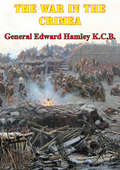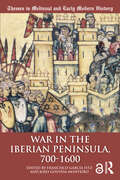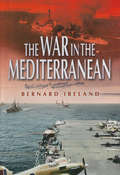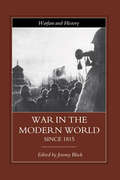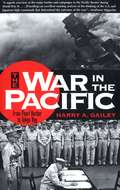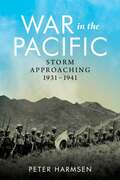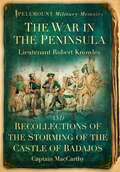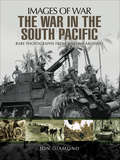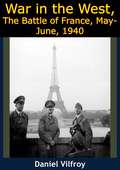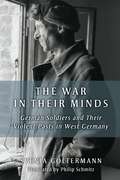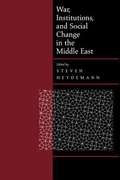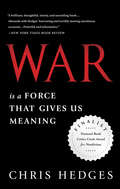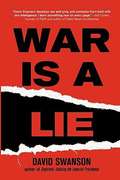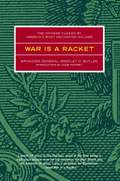- Table View
- List View
The War In The Crimea [Illustrated Edition]
by Lieutenant-General Sir Edward Bruce Hamley KCB KCMGThe finest eye-witness history of the Crimean War. Lauded at the time as the best history of the bloody and badly-led campaign, this edition has been richly illustrated with over two hundred and sixty maps, photos and portraits, of the battles, individuals and places involved in the Crimean War]General Sir Edward Hamley, K.C.B., initially served as an aide de camp to Sir Richard Dacres during the Russian War, but as his substantive rank was in the Royal Artillery he saw most of his service with the guns during the Crimean War. The Author was cited many times for his gallant conduct and bravery whilst working alongside the siege cannon in both the French and British Lines. He survived the Crimean War to become one of the figureheads of the Victorian military establishment, attaining the rank of Lieutenant General and holding the important post of the commandant of the Staff College.
War in the Deep: Pacific Submarine Action in World War II
by Edwin P. HoytNo one ever lived more dangerously than those who took to the depths of the Pacific Ocean in submarines during World War II. In this book the well-known author Edwin P. Hoyt tells the exciting story of those perilous days when submariners of the U. S. navy, at first outnumbered by their Japanese enemies, put to sea in outmoded boats armed with faulty torpedoes. War in the Deep recounts hazardous adventure after adventure experienced by both Americans and Japanese. It follows the comeback of American submarines and their daring forays that led to their vital role in the economic strangulation of Japan.
War in the Iberian Peninsula, 700–1600 (Themes in Medieval and Early Modern History)
by Francisco García Fitz João Gouveia MonteiroWar in the Iberian Peninsula, 700–1600 is a panoramic synthesis of the Iberian Peninsula including the kingdoms of Leon and Castile, Aragon, Portugal, Navarra, al-Andalus and Granada. It offers an extensive chronology, covering the entire medieval period and extending through to the sixteenth century, allowing for a very broad perspective of Iberian history which displays the fixed and variable aspects of war over time. The book is divided kingdom by kingdom to provide students and academics with a better understanding of the military interconnections across medieval and early modern Iberia. The continuities and transformations within Iberian military history are showcased in the majority of chapters through markers to different periods and phases, particularly between the Early and High Middle Ages, and the Late Middle Ages. With a global outlook, coverage of all the most representative military campaigns, sieges and battles between 700 and 1600, and a wide selection of maps and images, War in the Iberian Peninsula is ideal for students and academics of military and Iberian history.
War in the Iberian Peninsula, 700–1600 (Themes in Medieval and Early Modern History)
by Francisco García Fitz and João Gouveia MonteiroWar in the Iberian Peninsula, 700–1600 is a panoramic synthesis of the Iberian Peninsula including the kingdoms of Leon and Castile, Aragon, Portugal, Navarra, al-Andalus and Granada. It offers an extensive chronology, covering the entire medieval period and extending through to the sixteenth century, allowing for a very broad perspective of Iberian history which displays the fixed and variable aspects of war over time.The book is divided kingdom by kingdom to provide students and academics with a better understanding of the military interconnections across medieval and early modern Iberia.The continuities and transformations within Iberian military history are showcased in the majority of chapters through markers to different periods and phases, particularly between the Early and High Middle Ages, and the Late Middle Ages.With a global outlook, coverage of all the most representative military campaigns, sieges and battles between 700 and 1600, and a wide selection of maps and images, War in the Iberian Peninsula is ideal for students and academics of military and Iberian history.Chapter 6 of this book is freely available as a downloadable Open Access PDF at http://www.taylorfrancis.com under a Creative Commons [Attribution-Non Commercial-No Derivatives (CC BY-NC-ND)] 4.0 license.
The War in the Mediterranean
by Bernard IrelandMuch has been written about the conduct of the land battles and the commanders who faced each other yet, as the main protagonists realised at the time, success or failure rested on the effectiveness of their seaborne supply chain. Control of the Mediterranean was therefore absolutely crucial. In the final analysis it was the Allies' ability to dominate the Mediterranean that bought them victory but there is no denying that it was a 'damned close run thing'. In this authoritative study, Bernard Ireland brings a fresh clarity to the complexities and factors at play during this critical period.
War in the Modern World, 1990-2014 (Warfare and History)
by Jeremy BlackIn War in the Modern World, 1990-2014, Jeremy Black looks at the most modern of conflicts from the perspective that war is a central feature of the modern world. Arguing that understanding non-Western developments is crucial if the potential of Western war-making is to be assessed accurately, the book also asserts that knowing the history of conflict can only help future generations. Black argues for the need to emphasise the variety of military circumstances, as well as the extent to which the understanding of force and the definitions of victory and defeat are guided by cultural assumptions. War has a multi-faceted impact in the modern world, and this book shows its significance. As the latest volume in the Warfare and History series, this title takes a global and historical perspective on modern warfare, enabling the reader to approach familiar conflicts through a new analytical framework. This book is an invaluable resource for all students of the history of modern warfare.
War in the Modern World since 1815 (Warfare and History)
by Jeremy BlackConflict is central to human history. It is often the cause, course and consequence of social, cultural and political change. Military history therefore has to be more than a technical analysis of armed conflict. War in the Modern World since 1815 addresses war as a cultural phenomenon, discusses its meaning in different socities and explores the various contexts of military action.
War in the Pacific: From Pearl Harbor to Tokyo Bay
by Harry GaileyGailey (history, San Jose State U. ) details the performance of Japanese and Allied naval, air, and land forces in every major military operation in the Pacific theater in WWII. He examines the events leading up to the war; compares the Japanese and American economies and societies, war plans, and equipment; and chronicles actions from the early Allied defeats in the Philippines to the final agonies of the Japanese people. Contains b&w photos and maps. Annotation c. by Book News, Inc. , Portland, Or.
War in the Pacific: Storm Approaching 1931 - 1941 (War In The Far East Ser. #1)
by Peter HarmsenWar in the Pacific is a trilogy of books comprising a general history of the war against Japan; unlike other histories it expands the narrative beginning long before Pearl Harbor and encompasses a much wider group of actors to produce the most complete narrative yet written and the first truly international treatment of the epic conflict. The First book in the Series Storm Approaching 1931-1941, demonstrates how Japan and China's ancient enmity grew in the late nineteenth and early twentieth centuries leading to increased tensions in the 1930s which exploded into conflict in 1937. This book will take the relatively familiar stories – such as Guadalcanal, Iwo Jima – and place inside a much less well-known global narrative. Books 2 and 3 in the series are set for release in 2022.,
War in the Pacific: Formidable Foe – 1942-1943 (War In The Far East Ser. #1)
by Peter HarmsenWar in the Pacific is a trilogy of books comprising a general history of the war against Japan; unlike other histories it expands the narrative beginning long before Pearl Harbor and encompasses a much wider group of actors to produce the most complete narrative yet written and the first truly international treatment of the epic conflict.War in the Pacific: Formidable Foe – 1942-1943 Details the astonishing transformation that took place from 1942 to 1943, setting the Allies on a path to final victory against Japan. The central importance of China is highlighted in a way that no previous general history of the war against Japan has achieved.
The War in the Peninsula and Recollections of the Storming of the Castle of Badajos: Some Letters of a Lancashire Officer
by Robert Knowles Ian Fletcher Captain MacCarthy MacCarthyLieutenant Knowles served in the 7th (Royal) Fusiliers 1811-1813, seeing action in several battles, being wounded at the storming of Badajoz and at the battle of Salamanca. He was killed at Roncesvalles on 25 July 1813 during the Battle of the Pyrenees. By combining the overall picture as painted by Lt Knowles with the specific, bloody narrative of the storming of the Castle by Captain MacCarthy in one volume, this work is not only fantastic value for money but also offers the discerning reader a whole new perspective on the campaign. What did these two men – of different temperaments – make of events? Wellington had watched helplessly at Badajos as the flower of his army was smashed against the ramparts of Badajos: the 4th and Light Divisions attacked no less than 40 times. When they finally succeeded, an orgy of rape, pillage and destruction followed that even the Iron Duke could not quell. What did both men have to say about this? Both of these rare classics are essential reading for students of the period.
War in the Ring: Joe Louis, Max Schmeling, and the Fight between America and Hitler
by John Florio Ouisie ShapiroWar in the Ring presents a riveting nonfiction book for kids about a boxing match that represented the growing tensions between the United States and Nazi Germany in the lead up to World War II.Joe Louis was born on an Alabama cotton patch and raised in a Detroit ghetto. Max Schmeling grew up in poverty in Hamburg, Germany. For both boys, boxing was a path out and a ladder up. Little did they know that they would one day face each other in a pair of matches that would capture the world's attention.Joe grew into a symbol of inspiration to a nation of Black Americans hoping to carve a slice of the 'American Dream' in a racially fractured country. Max, on the other hand, became a Nazi symbol for the superiority of the Aryan race. The battles waged between Joe and Max still resonate, and the cultural implications of the international sensation continue to reverberate far past the ring.
War in the Shadows: Resistance, Deception and Betrayal in Occupied France
by Patrick MarnhamIn 1962 the young Patrick Marnham set off by car for a small village in central France. There he was taught French by an imperious countess, who he later discovered had fought in the Resistance until, betrayed, she was sent to Ravensbrück concentration camp. On the very same day that his hostess&’s network was broken, Jean Moulin, de Gaulle&’s delegate as head of the combined Resistance forces, was arrested in Lyons, where he was tortured by Klaus Barbie before dying in Gestapo custody. Was this coincidence, or were these events connected? The anonymous letter writer suggested a key to the mystery. Using a knowledge of France gained from 12 years as the Independent&’s Paris correspondent, and subsequent research in archives in England and France, Marnham set out to discover the truth about the betrayal of the old lady who had become his tutor and friend. Following a trail leading from London through Occupied Europe to the rank and file Resistance in lost corners of France, he has unravelled the story of a complex wartime deception, involving British, American and French intelligence services. The War in the Shadows shines a light on the brutality and cynicism of the Secret War and reveals how it was actually fought. The result is a story of ruthless double-dealing worthy of John le Carré, but with this difference: it is not a fiction.
The War in the South Pacific (Images Of War Ser.)
by Jon DiamondThe Japanese invaded the Solomon Islands in May 1942 with the aim of building an airfield at Guadalcanal. After an epic six month struggle they were repulsed and the island became a staging base for US Admiral Halsey and his South PacificForce. Comprising powerful naval, marine and army assets as well as land and carrier-based aircraft, Halseys Forces mission was to neutralise the Japanese presence in the South Pacific before moving on to Japan itself. As explained and depicted in this fascinating book, the campaign was eventually successful but only after some of the bitterest fighting of the Second World War. The fanatical opposition called for extreme measures from US, British and Australian land, seas and air forces. With detailed narrative and captions, the many archival photographs in The War in the South Pacific make for a superb record of this legendary conflict.
War in the West, The Battle of France, May-June, 1940: The Battle Of France May-june 1940
by Daniel VilfroyOriginally published at the height of World War II, this book provides an in-depth analysis of how and why France was beaten by Germany in May and June of 1940.Author Daniel Vilfroy closely examines both the French and German tactics and strategies employed during this period, and also explores the pre-war "Crisis of Art of War in France," the life of French soldiers in 1940, and discusses in detail the nature of modern warfare.
War in the Wilderness: The Chindits in Burma 1943-1944
by Tony ReddingWar in the Wilderness is the most comprehensive account ever published of the human aspects of the Chindit war in Burma. The word ‘Chindit’ will always have a special resonance in military circles. Every Chindit endured what is widely regarded as the toughest sustained Allied combat experience of the Second World War. The Chindit expeditions behind Japanese lines in occupied Burma 1943–1944 transformed the morale of British forces after the crushing defeats of 1942. The Chindits provided the springboard for the Allies’ later offensives. The two expeditions extended the boundaries of human endurance. The Chindits suffered slow starvation and exposure to dysentery, malaria, typhus and a catalogue of other diseases. They endured the intense mental strain of living and fighting under the jungle canopy, with the ever-present threat of ambush or simply ‘bumping’ the enemy. Every Chindit carried his kit and weapons (equivalent to two heavy suitcases) in the tropical heat and humidity. A disabling wound or sickness frequently meant a lonely death. Those who could no longer march were often left behind with virtually no hope of survival. Some severely wounded were shot or given a lethal dose of morphia to ensure they would not be captured alive by the Japanese. Fifty veterans of the Chindit expeditions kindly gave interviews for this book. Many remarked on the self-reliance that sprang from living and fighting as a Chindit. Whatever happened to them after their experiences in Burma, they knew that nothing else would ever be as bad. There are first-hand accounts of the bitter and costly battles and the final, wasteful weeks, when men were forced to continue fighting long after their health and strength had collapsed. War in the Wilderness continues the story as the survivors returned to civilian life. They remained Chindits for the rest of their days, members of a brotherhood forged in extreme adversity.
The War in Their Minds: German Soldiers and Their Violent Pasts in West Germany
by Philip Schmitz Svenja GoltermannHistorians are increasingly looking at the sacrifices Germans had to make during World War II. In this context, Svenja Goltermann has taken up a particularly delicate topic, German soldiers' experience of violence during the war, and repercussions of this experience after their return home. Part I of her book explores the ways in which veterans' experiences of wartime violence reshaped everyday family life, involving family members in complex ways. Part II offers an extensive analysis of the psychiatric response to this new category of patient, and in particular the reluctance of psychiatrists to recognize the psychic afflictions of former POWs as constituting the grounds for long-term disability. Part III analyzes the cultural representations of veterans' psychic suffering, encompassing the daily press, popular films, novels, and theater. Originally published in German as Die Gesellschaft der Uberlebenden, The War in Their Minds examines hitherto unused source material--psychiatric medical files of soldiers--to make clear how difficult it was for the soldiers and their families to readjust to normal, everyday life. Goltermann allows these testimonies of violence, guilt, justification, and helplessness speak for themselves and sensitively explores how the pension claims of returning soldiers were to compete with the claims of the Holocaust victims to compensation.
War in Val D'Orcia: An Italian War Diary, 1943-1944
by Iris Origo<p>A classic of World War II, here in its first American edition. War in Val d'Orcia is Iris Origo's elegantly simple chronicle of daily life at La Foce, a manor in a Tuscan no-man's land bracketed by foreign invasion and civil war. <p>With the immediacy only a diary can have, the book tells how the Marchesa Origo, an Anglo-American married to an Italian landowner, kept La Foce and its farms functioning while war threatened to overrun it and its people. She and her husband managed to protect their peasants, succor refugee children from Genoa and Turrin, hide escaped Allied prisoners of war-and somehow stand up to the Germans, who in dread due course occupied La Foce in 1944 and forced the Marchesa to retreat under a hot June sun. <p>Fleeing eight impossible miles on foot, along a mined road under shell fire, with sixty children in tow, she sheltered her flock in the dubious safety of a nearby village. A few days later, official Fascism disappeared, and La Foce was ransacked by the retreating Wehrmacht. Here, as the restoration of La Foce begins, her book ends. <p>Beyond praise and above mere documentary value, War in Val d'Orcia belongs to the literature of humanity.</p>
War in Val d'Orcia: An Italian War Diary, 1943-1944
by Iris Origo Virginia NicholsonIn the Second World War, Italy was torn apart by German armies, civil war, and the Allied invasion. In a corner of Tuscany, one woman—born in England, married to an Italian—kept a record of daily life in a country at war. Iris Origo’s powerful diary, War in Val d’Orcia, is the spare and vivid account of what happened when a peaceful farming valley became a battleground.At great personal risk, the Origos gave food and shelter to partisans, deserters, and refugees. They took in evacuees, and as the front drew closer they faced the knowledge that the lives of thirty-two small children depended on them. Origo writes with sensitivity and generosity, and a story emerges of human acts of heroism and compassion, and the devastation that war can bring.
The War Inside
by Michal ShapiraThe War Inside is a groundbreaking history of the contribution of British psychoanalysis to the making of social democracy, childhood, and the family during World War II and the postwar reconstruction. Psychoanalysts informed understandings not only of individuals, but also of broader political questions. By asserting a link between a real 'war outside' and an emotional 'war inside', psychoanalysts contributed to an increased state responsibility for citizens' mental health. They made understanding children and the mother-child relationship key to the successful creation of a democratic citizenry. Using rich archival sources, the book revises the common view of psychoanalysis as an elite discipline by taking it out of the clinic and into the war nursery, the juvenile court, the state welfare committee, and the children's hospital. It traces the work of the second generation of psychoanalysts after Freud in response to total war and explores its broad postwar effects on British society.
War, Institutions and Social Change in the Middle East
by Steven HeydemannA fresh look at the effects of war on state and society in the Middle East, challenging traditional assumptions based on European experience. The authors argue that war has destabilized Middle Eastern states and eroded national cohesion.
War Is a Force that Gives Us Meaning
by Chris Hedges<p>As a veteran war correspondent, Chris Hedges has survived ambushes in Central America, imprisonment in Sudan, and a beating by Saudi military police. He has seen children murdered for sport in Gaza and petty thugs elevated into war heroes in the Balkans. Hedges, who is also a former divinity student, has seen war at its worst and knows too well that to those who pass through it, war can be exhilarating and even addictive: “It gives us purpose, meaning, a reason for living.” <p>Drawing on his own experience and on the literature of combat from Homer to Michael Herr, Hedges shows how war seduces not just those on the front lines but entire societies—corrupting politics, destroying culture, and perverting basic human desires. Mixing hard-nosed realism with profound moral and philosophical insight, <i>War Is a Force that Gives Us Meaning</i> is a work of terrible power and redemptive clarity whose truths have never been more necessary.</p>
War Is a Lie
by David SwansonWAR IS A LIE is a thorough refutation of every major argument used to justify wars, drawing on evidence from numerous past wars, with a focus on those wars that have been most widely defended as just and good. This is a handbook of sorts, a manual to be used in debunking future lies before future wars have a chance to begin. For more information visit WarIsALie.org.
War Is a Racket: The Antiwar Classic by America's Most Decorated Soldier
by Smedley Darlington Butler Jesse VenturaWar Is a Racket is the title of two works, a speech and a booklet, by retired US Marine Corps Major General and two-time Medal of Honor recipient Smedley Darlington Butler. In these works, Butler frankly discusses from his experience as a career military officer how business interests commercially benefit from warfare. After his retirement from the Marine Corps, Gen. Butler made a nationwide tour in the early 1930s giving his speech, "War Is a Racket." The speech was so well received that he wrote a longer version that was published in 1935, now republished with a foreword by former governor of Minnesota and New York Times bestselling author Jesse Ventura.Jesse Ventura reviews Major General Butler's original writings and brings them up to date, relating them to our current political climate. Butler was a visionary in his day, and Ventura works to show how right he was and how wrong our current democracy is. Read for the first time Butler's words with Ventura's witty, yet insightful spin on this relevant work that will appeal not only to military historians, but also to those interested in the state of our country and the entire world.
War is a Racket
by Adam Parfrey Smedley D. ButlerGeneral Smedley Butler's frank book shows how American war efforts were animated by big-business interests. This extraordinary argument against war by an unexpected proponent is relevant now more than ever.Originally printed in 1935, War Is a Racket is General Smedley Butler's frank speech describing his role as a soldier as nothing more than serving as a puppet for big-business interests. In addition to photos from the notorious 1932 anti-war book The Horror of It by Frederick A. Barber, this book includes two never-before-published anti-interventionist essays by General Butler. The introduction discusses why General Butler went against the corporate war machine and how he exposed a fascist coup d'etat plot against President Franklin Roosevelt. Widely appreciated and referenced by left- and right-wingers alike, this is an extraordinary argument against war - more relevant now than ever.
